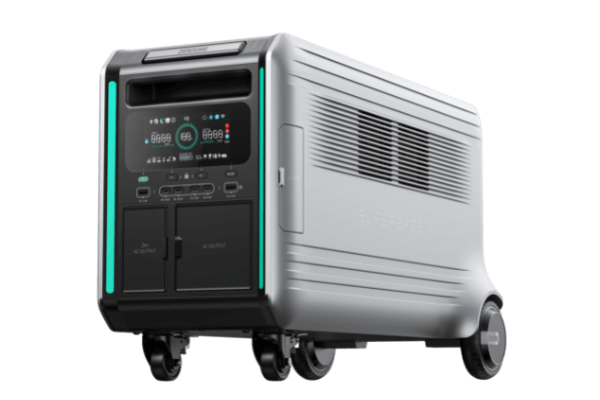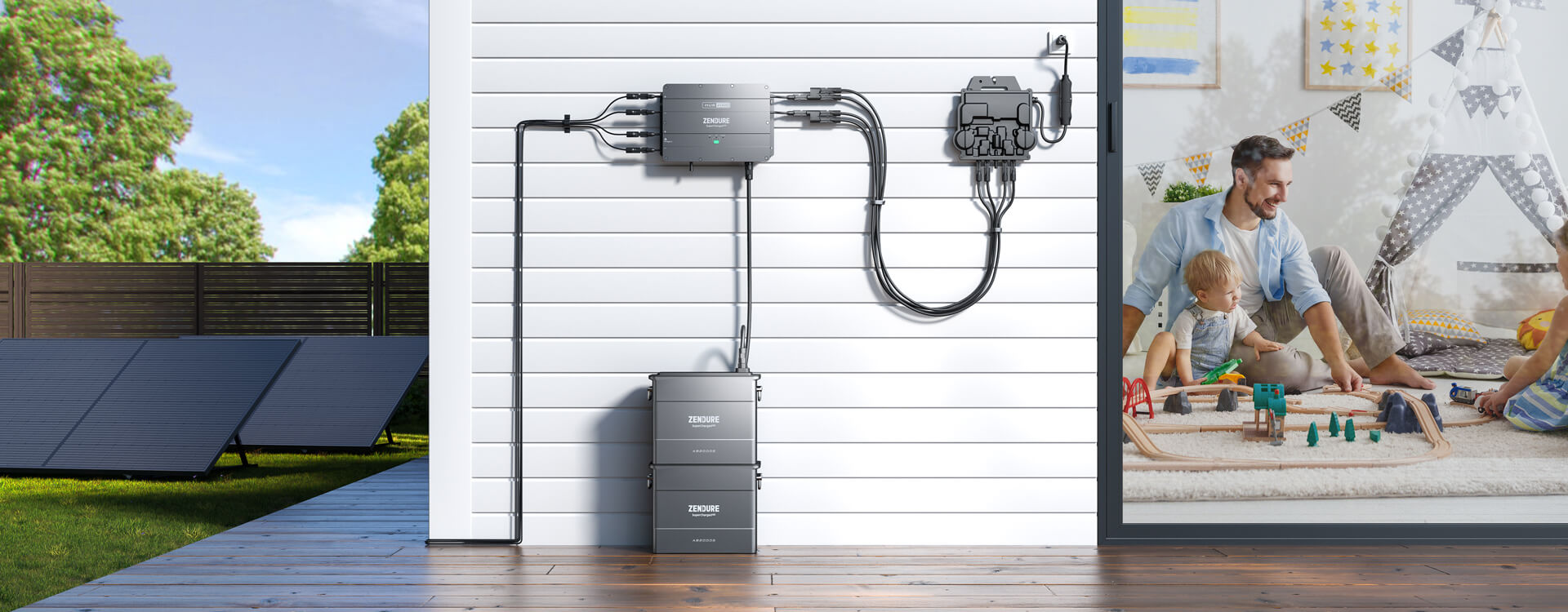How Much Does an Off-Grid Solar System Cost?

In the era where sustainable living is a necessity, the need for energy independence has become an empowering journey for many. Research shows that about 67% of adult Americans prioritize developing sustainable energy sources. Off-grid solar systems are among the top-ranked eco-friendly solutions, thanks to their ability to illuminate a path to a greener and more self-reliant future.
This post will uncover the world of off-grid solar systems, including the different types, their cost, and tips for reducing the off grid solar system cost. Dive in!

What is an Off-grid Solar System?
An off-grid solar system is a network of solar panels and batteries connected to store power and function independently from the main power grid. These systems promote an off-grid lifestyle that revolves around self-sustainability and energy independence.
"Off the grid" living has become popular over the past years due to an alarming increase in the cost of fuel, food, energy, and other necessities. Also, the recent rise in the price of electricity has made many consumers seek an alternative power source for their homes.
Solar energy is a well-known green energy that you can use to power your property independently without depending on the electrical grid. However, you require various components to set up an off-grid solar system. They include:
- Solar Panels: Available in various types and prices. The cost of acquiring these units will depend on the number and the mounting design. On average, solar panels cost around $2.76 per watt.
- Charge Controller:These units control the amount of electric current entering and drawing out of your solar batteries. Their price generally depends on the power rating and is available at an average cost of $50-$1,000.
- Hybrid Power Inverter:These are the cornerstone of your off-grid system and function by transforming Direct Current (DC) in the batteries into Alternating Current (AC). They are available at an average cost of $3,000-$13,000.
- Battery Bank: These are also among the defining components of your off-grid solar system, as they allow your home to be powered without solar energy. Their average cost ranges between $10,000 and $30,000.
Different Types of Off-grid Solar Systems
Off-grid solar systems come in various designs and configurations. Here are some common types you may consider installing on your property:
#1. Stand-Alone Solar Systems
These are the standard off-grid solar systems, mainly consisting of solar panels, charge controllers, inverters, and batteries. These components are connected to produce electric energy to power common household appliances.
#2. Hybrid Solar Systems
These systems combine solar panels and secondary energy sources such as wind turbines or gasoline generators. They provide enhanced reliability by providing a continuous power supply even during prolonged periods of low sunlight. Also, they use advanced control technology to switch intelligently between solar power and secondary source depending on energy demand and availability.
#3. Portable Solar Systems
These systems are designed for flexibility and mobility. Generally, they consist of foldable solar panels, rechargeable batteries, and integrated charge controllers. You can use them for camping, RVs, boats, and other outdoor activities since they are a convenient and eco-friendly way to power small appliances and devices on the go.
#4. Remote Area Power Systems (RAPS)
Off-grid solar systems are specifically designed for remote or isolated locations where connecting to a centralized power grid is not feasible or cost-effective. They cater to the energy needs of small communities, remote cabins, research stations, and telecommunication infrastructure in challenging terrains.
How Does an Off-grid Solar System Differ from Other Solar Systems?
An off-grid solar system differs from other solar systems primarily in terms of its design, functionality, and purpose. The key distinctions between an off-grid solar system and other solar systems, such as grid-tied solar systems, lie in their connection to the power grid, battery storage, and energy independence. Let's explore these differences:
1. Connection to the Power Grid
Off-Grid Solar System
An off-grid solar system operates independently of the power grid. It is not connected to any centralized utility grid, and all the electricity generated by the solar panels is consumed on-site or stored in batteries for later use. These systems are commonly used in remote or rural areas where the grid connection is unavailable or impractical.
Grid-Tied Solar System
A grid-tied solar system is connected to the power grid. Solar panels feed excess electricity into the grid when they generate more power than the property's energy demands. This surplus electricity is often credited to you through net metering, reducing the electricity bill and promoting clean energy production.
2. Battery Storage
Off-Grid Solar System
One of the defining features of an off-grid solar system is the inclusion of battery storage. Since off-grid systems are not connected to the grid, they need batteries to store excess energy generated during sunny periods. These batteries are then used to supply power during periods of low sunlight or at night, ensuring a continuous energy supply.
Grid-Tied Solar System
These systems generally do not include battery storage as they rely on the grid for power during low solar output periods. Without batteries, excess electricity generated is sent back to the grid for others to use. The homeowner consumes electricity from the grid when solar generation is insufficient.
3.Energy Independence
Off-Grid Solar System
These systems provide complete energy independence. They allow you to become self-reliant and not dependent on the grid for power needs.
Grid-Tied Solar System
These systems offer environmental benefits and cost savings by reducing reliance on fossil fuel-based electricity. However, they do not grant energy independence since they rely on the grid as a backup power source during periods of low solar production.
4. Suitability and Location
Off-Grid Solar System
These systems are well-suited for remote areas, far from the reach of utility grids, where installing power lines would be expensive or unfeasible. They are also an excellent choice if you are seeking to become self-sufficient and reduce your carbon footprint.
Grid-Tied Solar System
These systems are more common in urban and suburban areas where the power grid is readily available. They are suitable if you seek to reduce electricity bills and contribute to renewable energy generation without completely disconnecting from the grid.
How Much Does an Off grid Solar System Cost?
The average cost of an off-grid solar system is $45,000- $65,000, almost double the price of a grid-tied solar system. Despite the costly nature of these systems, off-grid systems offer you excellent customization and freedom, unlike standard systems from top solar companies.
Factors Affecting the Off Grid Solar System Cost
There are several factors affecting the off-grid solar system cost. The size of the system, local installation expenses, additional accessories, and ongoing maintenance all influence the final price tag. While basic setups may entail a few hundred dollars, more intricate configurations can extend to several thousand dollars.
The number of solar panels in your system directly correlates with the amount of power you can generate. An average household typically requires between 17 and 21 solar panels to offset utility bills with solar energy. You can adjust the number of panels to align with your budget and energy requirements.
The installation location of your solar panels significantly impacts the installation cost. Opting for rooftop installation is usually more cost-effective than ground-mounted installations. Consult an off-grid solar panel system installer to ascertain the precise price for a facility tailored to your needs. Their expertise will guide you toward a system that optimally aligns with your energy goals and financial considerations.
Tips for Reducing the Cost of Off-grid Solar Systems
Here are Zendure's top five tips for reducing off grid solar system cost:
1. Energy Efficiency
Prioritize energy-efficient appliances and lighting to reduce overall energy consumption, maximizing the efficiency of your off-grid solar system. This step ensures that your system's capacity matches your energy needs, minimizing unnecessary costs.
2. Buy and Install in Phases
Start with essential components and gradually expand your system as needed. This approach spreads out the initial investment, making it more manageable and allowing you to assess system performance before making further additions.
3. Consider Roof Mounting Arrangement
Opt for rooftop solar panel installations whenever possible. Roof mounting is often more cost-effective than ground-mounted setups, saving installation expenses and efficiently utilizing available space.
4. Begin with a Beginner Battery Bank
Start with a primary battery bank that meets your immediate storage requirements. As your energy demands grow, you can expand the battery capacity over time, avoiding excessive upfront costs.
5. Package Pricing Pays
Look for package deals from reputable suppliers. Bundled solar system packages often come at discounted rates compared to purchasing individual components separately, leading to cost savings without compromising quality.
Wrapping Up
An off-grid solar system is an energy-efficient, sustainable, and fantastic way to achieve energy independence. These systems are available in various designs, each with a unique capability and performance. Fortunately, Zendure supplies you with affordable, top-notch components for your off-grid solar system.
From solar panels, solar batteries, and power inverters to charge controllers, our products are designed to offer you unquestionable performance. Contact us now to embark on a journey to power independence.






















